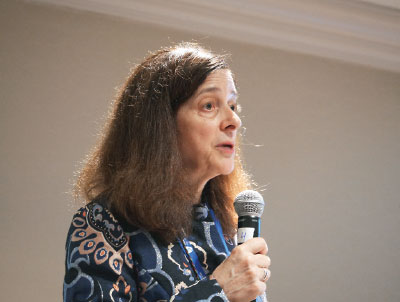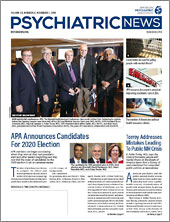Early treatment of psychosis has moved out of the research arena into on-the-ground community practice, said Lisa Dixon, M.D., director of OnTrackNY, one of the first and most well-developed early psychosis treatment programs. She talked about the program in a keynote address at the Early Psychosis Preconference held in conjunction with APA’s IPS: The Mental Health Services Conference in New York last month.
Dixon, who is also a professor of psychiatry at Columbia University and editor of the APA journal Psychiatric Services, told attendees that the expansion of early psychosis programs has extended evidence-based care to more patients, likely reducing the duration of untreated psychosis and improving patients’ course of illness and treatment outcomes.
Long-term sustainability remains a challenge for early psychosis programs, however, requiring advocates to pay attention not just to patient care but also public health policy, funding, and reimbursement, Dixon said.
The preconference brought together some 350 mental health professionals involved in the identification and treatment of individuals with psychosis and included a rich variety of presenters. Among the program’s topics were the role of peer supports, issues in financing first-episode and early psychosis clinics, challenges and opportunities related to transitioning patients out of treatment and follow-up, managing first-episode patients who are also using cannabis and other substances, and incorporation of culturally competent, coordinated specialty care, among others.
Delivering the afternoon keynote was Dost Ongur, M.D., Ph.D., director of the Division of Psychotic Disorders at McLean Hospital and editor of JAMA Psychiatry. He spoke about the importance of recognizing affective psychosis among patients presenting at early psychosis treatment programs; some of these patients may be in the early stages of bipolar disorder.
Dixon presented an overview and evaluation of OnTrackNY, a program of the Center for Practice Innovations at Columbia University/New York State Psychiatric Institute and the New York State Office of Mental Health. The program, established in 2013, has 23 sites in New York state and serves individuals aged 16 to 30 who have experienced nonaffective psychosis for less than two years. (OnTrackNY oversees the 23 sites, but the sites are administered by local agencies.)
Expansion of the program was stimulated in part by funding from the Substance Abuse and Mental Health Services Administration (SAMHSA). The agency was mandated by Congress in 2014 to increase state block-grant funding by 5% to be used specifically for early psychosis treatment; in 2016 that was increased to 10%. Between 2013 and 2014 the number of OnTrackNY sites grew from four to 11, and in 2016—after the 10% set aside—jumped to 20.
Dixon said OnTrackNY also received support from the state and other grants from SAMHSA.
The early psychosis treatment movement grew out of the National Institute of Mental Health’s Recovery After Initial Schizophrenia Episode (RAISE) study. The study demonstrated the success of coordinated specialty care for individuals with early psychosis; coordinated specialty care promotes shared decision making and uses a team of specialists who work with patients to create a personal treatment plan that may include psychotherapy, medication management, family education and support, case management, and work or education support.
According to a 2018 report of the National Association of State Mental Health Program Directors (NASMHPD), there were 263 coordinated specialty care programs for early psychosis last year.
Using a framework developed by health services researchers to evaluate program implementation known as RE-AIM (Reach, Effectiveness, Adoption, Implementation, and Maintenance), Dixon outlined some of the lessons learned from OnTrackNY to date:
•
Reach: OnTrackNY has served over 1,600 patients since 2013. The program has the capacity to care for 900 patients at a time, but Dixon said that Medicaid data on incidence of first-episode psychosis suggest that many more patients may be in need of such services. “While the growth of OnTrackNY has been remarkable, the actual need may be closer to 2,000 slots based on assumptions about the incidence of schizophrenia and nonaffective psychosis,” she said.
The duration of untreated psychosis for patients is approximately 7.5 months, an improvement over other samples in the literature, but exceeding the program goal of less than three months. And Dixon said there is an overreliance on referrals from hospitals and the mental health system and a need for better ways to find and attract individuals in need of treatment in a variety of community settings before their first hospital admission: An estimated 44% of referrals come from psychiatric inpatient units and 24% from outpatient mental health professionals.
Additionally, Dixon said, turnover among staff at programs and at the agencies that operate them negatively affects the ability to reach out to schools and other local entities for referrals. “There is a tension between reaching out to high-yield referrers, especially inpatient units, and doing extensive community work so that individuals are referred before a first admission,” Dixon said.
•
Effectiveness: Dixon said the key service elements of coordinated specialty care for early psychosis include case management, supported employment and education, psychotherapy, family education and support, pharmacotherapy, and coordination with primary care.
She said OnTrackNY’s rates of participation in treatment, data on rehospitalization, work and school status, and overall functioning are positive: for instance, over 70% of enrolled patients were working or enrolled in school after six months of treatment. However, there is substantial variability across clinics, and more needs to be done to identify and help patients with poorer outcomes, Dixon said.
•
Adoption: The program has thrived in a diversity of sites and locations across the state, but sustainability at the agency level—that is, the ability to continue funding and staffing a program—is a challenge. And adoption in rural areas continues to lag behind that in urban areas.
•
Implementation: OnTrackNY developed training models to ensure “fidelity,” or the ability of clinics to abide by a model of treatment standardized across sites. Most OnTrackNY teams have met that standard; the most common unmet domains are metabolic screening of patients and use of peer supports; the latter was recently added to the model of treatment.
•
Maintenance: OnTrackNY has been fortunate in having the financial support of the state, but long-term funding remains a challenge. Costs exceed revenue: According to a study by Thomas Smith, Ph.D., and colleagues published in the March Psychiatric Services, the average cost per Medicaid patient per month enrolled in OnTrackNY was $1,375, while the average reimbursement for the same patient per month was $622. Dixon said there is also a need for a more systematic approach to patient discharge, step-down to less-intensive services, and long-term follow-up.
“Progress in the implementation of early intervention programs for individuals experiencing early psychosis is palpable,” Dixon said. “The lessons learned inspire strategies for ongoing improvement.” ■
Information about OnTrackNY is posted
here. Information about the RAISE study is posted
here. The NASMHPD report is posted
here.

